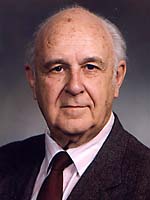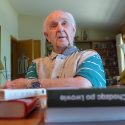Madison geneticist looks back on crowded, stellar career
Waclaw Szybalski, a University of Wisconsin–Madison professor emeritus of oncology, has a string of scientific achievements that could easily have merited at least one Nobel Prize, and his work has laid foundations for several Nobels won by others. He’s mentored a string of highly successful scientists and collaborated for 60 years with the biggest names in the field.
But all of this depended on a different type of triumph — a conquest of the U.S. immigration bureaucracy.

Szybalski
Born in 1921 in Lwow, Poland, to a family of intelligentsia (his father was an electrical engineer; his mother used crystallography to study the structure of molecules), Szybalski survived World War II and serial invasions by the Soviet Union, Germany and then the U.S.S.R. once again. “I wanted to enroll at the aeronautic department of the polytechnic university of Lwow in 1939, but we were just occupied by the Soviet Union and they did not let local people enter aviation,” Szybalski says from his office in McArdle Laboratory. “After 22 months, the German invasion simplified things. They just closed all the schools.”
In 1949, after earning a Ph.D. in chemistry from the Institute of Technology in Gdansk, he moved to Copenhagen, which he found too close to the Soviet Union: “I had already been a captive, and I decided I had to be further away.” A functionary at the U.S. embassy told him he’d have to wait 10 years for a visa, so Szybalski phoned the consul directly, secured an appointment and got the details: He had, supposedly, been born in the Soviet Union. “I said I was never in the Soviet Union, the Soviet Union came to me, but in the U.S. book, Poland had been given to Mr. Stalin, because he was so nice!” A little digging in the consulate library revealed that visas were available to teachers. “Being a teacher sounded fine to me,” he says, “so I brought in my papers and got a visa in three or four days; it was some sort of a record.”
In person, Szybalski is gracious, considerate, wryly humorous, but the persistence and imagination that overwhelmed the immigration bureaucracy are not exactly recessive traits. Szybalski was working on genetics before 1953, when the structure of DNA was deciphered, and he has continued publishing long after the human genome was revealed, in all its 3-billion-letter complexity, in 1998.
The latest publication date in his CV, after all, is 2011.
Insight, as much as persistence, is a Szybalski hallmark, says former postdoctoral student Frederick Blattner, a professor of genetics and entrepreneur in the field of genetic computing. “He’s a poet of the scientific method, able to speculate, to develop tests and hypotheses; he had an uncanny way of unraveling complex problems.”
In 1950, recommendations from eminent Danish scientists, including the physicist Niels Bohr, helped Szybalski land a job at a genetics lab at Cold Spring Harbor on Long Island, N.Y. At Cold Spring Harbor, which was already a capital of the emerging science of molecular biology, he plunged into the study of antibiotic resistance. These “miracle drugs” had only recently entered broad usage, but bacteria were already evolving resistance, and in 1952 Szybalski invented a method to measure and overcome that resistance. His results led him to advocate multiple antibiotic treatment for tuberculosis, which largely blocks the evolution of resistance. Although it was resisted at first, today multidrug therapy is a standard treatment for tuberculosis, AIDS, leukemia and other diseases.
Szybalski reverently remembers the collaborative, engaged atmosphere at Cold Spring Harbor Laboratory, as the institution is now called. “We were a small crew, we all knew each other and we could do an experiment one day, and the next morning, have a result we could discuss. In the 1950s, ’60s and even ’70s, since was so little was known, we could ask a simple question and get a clear-cut answer.” The world of genetics was tiny and tight-knit, he adds. “Some of us thought that maybe we should not publish using our names, because everybody would know who did the experiment anyway.”
To Szybalski, Cold Spring Harbor remains a “home away from home.” He proudly notes that it recently dedicated the Waclaw Szybalski Annex to its Carnegie library in honor of his six decades of scientific collaboration and achievement.
In 1960, after a few years at Rutgers University, Szybalski joined the McArdle Laboratory at UW–Madison and started pioneering studies on a virus that infects bacteria. The virus, called lambda phage, became a mainstay in Szybalski’s career-long interest in how genes are transferred, modified and regulated. At McArdle, he also learned to alter DNA so cancer cells would be more susceptible to radiation. “I thought this would be a cure for cancer, and it would have been if we did not have a liver, which detoxifies compounds,” he says. “That’s great, but the liver destroys the good stuff in this case.” Although a clinical failure, the studies provided final proof that radiation kills cells by damaging their DNA.
In 1962, Szybalski became the first to insert DNA into human cells, and the next year, the first to create functional DNA in a glass dish. Szybalski invented HAT selection, a technique for separating those cells that had been genetically modified. A decade later, HAT selection became key to a Nobel-winning invention called the monoclonal antibody. Monoclonals, produced by batches of identical immune cells, can recognize specific proteins and cell types and are used in innumerable areas of research and medicine, such as cancer, rheumatoid arthritis and pathogen identification.
Szybalski combined his lab work with a big-picture view of the implications of the burgeoning field of genetics. In 1962, he coined “gene therapy” while proposing the repair of defective DNA. In 1974, the growing ability to manipulate DNA led him to propose a new field of a “synthetic biology” that would create life rather than modify it.
In hindsight, many discoveries tend to look almost inevitable, but anybody can play the hindsight game. How did Szybalski choose his research topics? “I was ambitious,” he says. “I knew what questions had been asked for years, for centuries: What is life? What is the essence of life? And that was DNA!”
DNA — the instruction manual for life that sustains and changes itself through time — is one theme in Szybalski’s career, but a second one is more pedestrian: engineering or, more precisely, tools. Growing up in Poland, Szybalski was fascinated by airplanes. “I built model planes, flew them in competitions. I got into gliding as a sport and got an undergraduate degree in engineering.”
With this background, being called a “toolmaker” is a compliment. “Tool-making is what humans were designed for!” he says. “There are people who like to use their hands; when you need a tool, you make it. I had a grandfather in Poland who adored me. When I asked how a watch works, he invited a watchmaker to stay at his house, and every morning he’d show me how various watches work.”
In marriage, Szybalski opted for a hybrid of love and work. “My idea of marriage was to get the best possible collaborator. I met Elizabeth Hunter at Cold Spring Harbor. She is brighter than me. We had something in common, and could pursue the research together.” After decades of collaborating — their first joint paper was published before they even married in 1955 — Elizabeth Hunter Szybalska is now in declining health. Szybalski’s three children live in Arizona/Alaska, Florida and New York; none adopted their parents’ scientific calling.
Great scientists should make great mentors, and Szybalski, who in his time learned from leading lights of genetics, takes the obligation seriously. Around 1959, he helped recruit virologist/geneticist Howard Temin to McArdle. Temin was exploring an enzyme that, he believed, could pattern DNA on a related molecule called RNA, which reversed the accepted relationship of the two genetic molecules. Szybalski suggested that Temin use one of the techniques he had pioneered, which helped Temin prove his point. Then Szybalski learned that a competitor had discovered the same enzyme, now called reverse transcriptase. Exploiting his broad range of relationships, Szybalski contacted the editor of the journal Nature, ensuring that Temin and David Baltimore could publish their results side by side in Nature. In 1975, Baltimore and Temin shared a Nobel Prize for discovering reverse transcriptase, which soon turned out to be an essential component of HIV and other retroviruses.
Szybalski’s scientific progeny include many other leading lights of genetics and molecular biology at UW–Madison. “He has persistence, a very clear mind,” says James Dahlberg, a professor emeritus of biomolecular chemistry and a co-founder of Third Wave, a local biotech firm. “He could figure out the essentials of a problem and he would keep struggling until he solved it, and would use all the technology at hand to get the answer.”
“It seemed at first that he was making things too complicated, but in fact, they were complicated,” says Blattner. “In early molecular biology, there was a tendency to oversimplify, he tended to be more artistic, he knew a great deal, and kept a lot of things in his repertoire of facts. He was a great example of a mentor who could develop his students so they would become creatively effective, not just technologists who lack in imagination.”
Richard Burgess, founder of the UW Biotechnology Center, member of the McArdle lab, and another successful entrepreneur, says Szybalski “paid attention to detail in such a wide range of discoveries, and they all required creativity, new ways of thinking, and then keeping track of a great deal of complex stuff. This was before the computer, but he had advantage of having his own built-in computer.”

